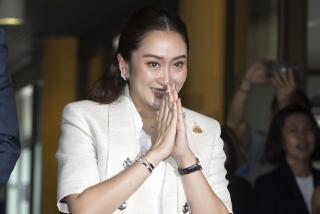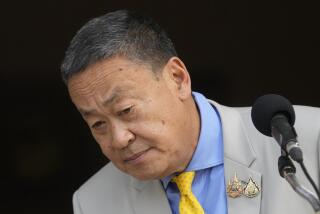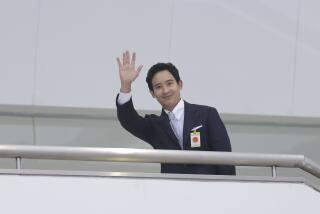Sihanouk Plan for Unity Regime Fails in Cambodia : Asia: Deal apparently collapses because of son’s objections. He wants assembly seated first.
- Share via
PHNOM PENH, Cambodia — Efforts to resolve Cambodia’s decades of political bickering appeared to have stumbled badly today when Prince Norodom Sihanouk, the man chosen to lead a new, national unity government, announced that the plan had collapsed.
Sihanouk, 72, said Thursday that he had agreed to serve as chief of state, prime minister and commander in chief of the armed forces. He appointed Hun Sen, the prime minister of the Phnom Penh government, and his son, Prince Norodom Ranariddh, leader of the opposition royalist party, to serve as deputy prime ministers.
The compromise would have allowed a new constituent assembly, chosen in six days of U.N.-supervised elections last week, to take office and draft a new constitution. The royalist party won the election with about 45% of the vote and the Phnom Penh regime received about 38%.
Ironically, the deal apparently collapsed not because of objections from Phnom Penh, which had agreed to serve in the new government, but from Ranariddh, Sihanouk’s 49-year-old son, who Sihanouk said questioned the legality of forming a government ahead of the seating of the 120-seat assembly.
“The only aim I had was to avoid a bloody conflict that Hun Sen warned could happen,” Sihanouk said. He said he was leaving to the Phnom Penh regime and his son’s party “any responsibility for bloody or tragic events.”
The question now looming over Cambodia is what action the Phnom Penh regime would take in response. Before the power-sharing arrangement was reached, it had threatened to reject the results of the elections because of “irregularities,” but many observers believed this was a panic reaction to having lost power after 14 years.
Sihanouk’s dramatic announcement Thursday setting up the national government appeared to have stunned officials of the U.N. Transitional Authority in Cambodia, who deployed 22,000 troops and civilian officials at a cost of $2.6 billion to arrange free and democratic elections last week.
Describing himself as the “father of the nation, the father of national unity and the father of national reconciliation,” Sihanouk declared: “Our people have suffered greatly and unjustly for the past 23 years. No one has the right to make them suffer anymore.”
It was clear UNTAC was not consulted. Sihanouk did not mention the agency in his statement and only informed its chief, Yasushi Akashi, of the “national government of Cambodia” at 5:30 p.m., when the old government was dissolved.
Describing the agreement as “extremely important,” Akashi said in a statement that a “new mechanism could be a necessary instrument for stability in Cambodia.”
The announcement also appeared to have come as a surprise to officials of FUNCINPEC, as the main opposition party is known. They said they were unaware of the compromise plan until it was publicly proclaimed. But Sihanouk said he had received the “clear agreement and unconditional support” of Ranariddh, but it was apparent from his subsequent statements that Ranariddh may not have been consulted.
The Cambodian People’s Party, the political movement of the Phnom Penh government, had issued a statement supporting the interim government for the sake of “peace, national reconciliation and national reconstruction.”
Khieu Kanarith, a spokesman for the outgoing government, called on the armed forces and other civil servants to stay calm. He said the government has received reports of potential unrest after the announcement of the voting results.
Nearly final returns in the elections showed that FUNCINPEC had won 45% of the popular vote, compared to 38% for the Cambodian People’s Party. A second opposition party, the Buddhist Liberal Democratic Party, trailed with 3%.
According to preliminary estimates, the voting should give FUNCINPEC about 57 seats in the 120-seat Constituent Assembly, with the Cambodian People’s Party receiving 52 seats and the Buddhist party getting about 10 seats.
Under the U.N.-brokered peace plan achieved in October, 1991, the assembly has three months to draft a constitution and form a government. UNTAC is supposed to remain during the transition period.
While FUNCINPEC came out the winner, it failed to garner a two-thirds majority, even in coalition with the Buddhist party, which is necessary to adopt a constitution. The Phnom Penh regime has enough seats to block any charter proposals, and it also controls the only functioning army in the country, its most potent bargaining chip.
Named in 1991 as the head of state by the Supreme National Council, a body composed of the four warring factions in Cambodia’s civil war, Sihanouk was not a candidate in last week’s national elections. He had been expected to run for president unopposed after the drafting of a new constitution.
As the magnitude of its defeat became clear early this week, the Phnom Penh government called on the United Nations to hold fresh elections in four provinces because of the alleged irregularities in the voting.
Cambodian People’s Party spokesman Sok An indicated Thursday that his party is prepared to accept the results, but he insisted that the irregularities had cost his party the elections.
BACKGROUND: NORODOM SIHANOUK
* Prince Norodom Sihanouk is one of the enduring characters of the world political scene, a flamboyant and often petulant leader who is nonetheless revered by Cambodia’s 8 million people. At the age of 18, in 1941, he was appointed to succeed his grandfather as King of Cambodia by the French colonial government of Indochina. He led the country to independence from France in 1953 and abdicated the throne two years later to form his own political movement. While he is indisputably Cambodia’s most popular figure, his rule in the 1950s is remembered as autocratic. Sihanouk’s government grew increasingly corrupt and unpopular, and in 1970 he was overthrown in a coup by his defense minister, Lon Nol, and the Cambodian National Assembly. He went into exile, returning only when the Lon Nol regime fell to the Communist Khmer Rouge in 1975. But a four-year reign of terror ensued, and Sihanouk was spared execution only because of the last-minute intervention of the Chinese government. In 1979, after Vietnam invaded to oust the Khmer Rouge, Sihanouk became the titular leader of a coalition of three guerrilla movements fighting the Vietnamese-installed government. However, he spent considerable time in exile in Beijing and North Korea, returning to Cambodia in November, 1991, to a rapturous welcome. But as the political war heated up between the Phnom Penh regime and the royalist party, Sihanouk absented himself from the country for months at a time, citing ill health.
More to Read
Sign up for Essential California
The most important California stories and recommendations in your inbox every morning.
You may occasionally receive promotional content from the Los Angeles Times.













